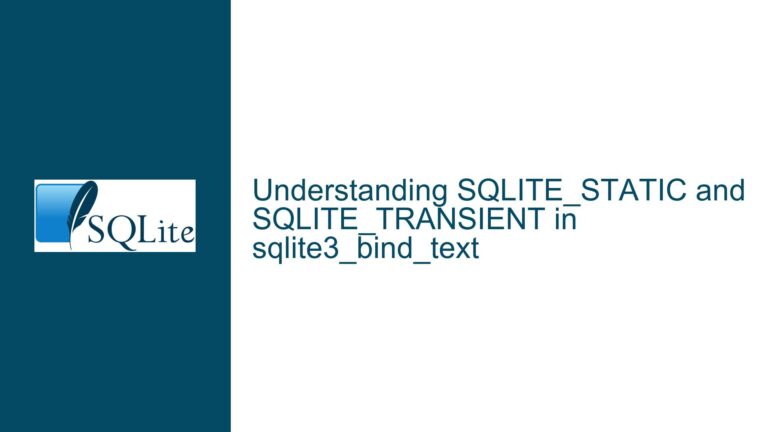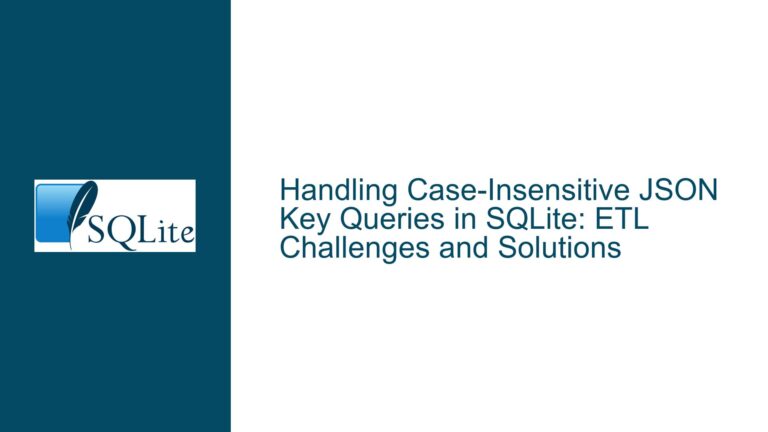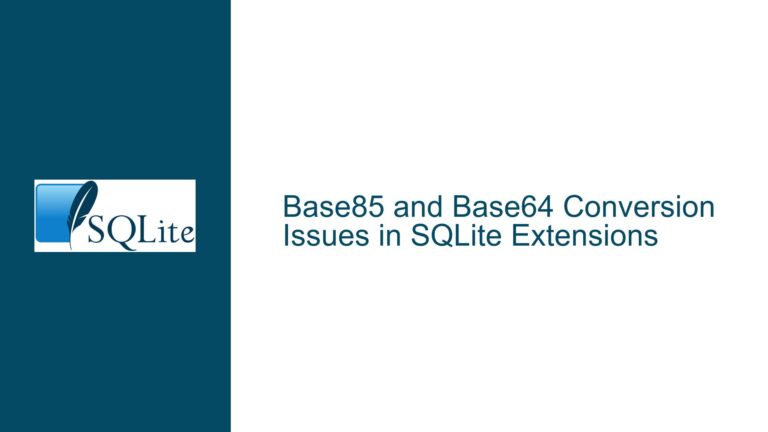Building SQLite for Apple Silicon: ARM Architecture Compatibility and Cross-Platform Performance Challenges
SQLite on Apple Silicon: Native ARM Builds, Rosetta 2 Efficiency, and Cross-Platform Driver Challenges
1. Architectural Differences Between Apple Silicon and Legacy Systems
The transition to Apple Silicon (ARM-based processors like the M1, M2, and subsequent generations) introduces unique challenges for SQLite deployment and performance optimization. Unlike traditional x86-64 architectures, Apple Silicon relies on a different instruction set, memory management, and thermal design. Native ARM builds of SQLite must account for compiler toolchain compatibility, instruction optimizations, and integration with Apple’s macOS frameworks.
A critical concern is benchmarking SQLite’s performance across two execution environments: native ARM binaries and x86-64 binaries running via Rosetta 2 translation. While Rosetta 2 enables backward compatibility, its emulation layer introduces overhead that may degrade performance for compute-intensive operations. However, SQLite’s efficiency often depends on I/O bottlenecks (e.g., SSD speed, filesystem interactions), which could overshadow differences in CPU architecture.
Cross-platform compatibility further complicates deployment. Developers using virtualization tools like Parallels Desktop to run Windows 10/11 ARM on Apple Silicon face challenges with SQLite driver availability. The absence of native Windows ARM drivers for SQLite forces users to rely on x64 emulation, which may fail due to incompatibilities in low-level system calls or memory addressing.
2. Factors Influencing Performance and Compatibility
Compiler Toolchain Configuration
Building SQLite for Apple Silicon requires a properly configured ARM-compatible compiler. Xcode’s default toolchain may generate suboptimal binaries if architecture-specific flags (e.g., -target arm64-apple-macos11) are not explicitly set. Incorrectly built binaries might exhibit crashes, memory leaks, or degraded performance due to mismatched CPU instructions.
Rosetta 2 Translation Overhead
Rosetta 2 dynamically translates x86-64 instructions to ARM, but this process introduces latency. Compute-heavy SQLite operations (e.g., complex joins, encryption via SQLCipher) may show significant slowdowns under Rosetta 2 compared to native ARM builds. However, I/O-bound workloads (e.g., bulk inserts, checkpointing) might see negligible differences since storage latency dominates execution time.
Hardware-Specific Optimizations
Apple Silicon’s unified memory architecture and GPU co-processors enable performance gains for specific workloads. For instance, SQLite’s in-memory databases could benefit from reduced NUMA (Non-Uniform Memory Access) overhead. However, thermal throttling in fanless devices like the MacBook Air may limit sustained performance during prolonged queries.
Cross-Platform Driver Availability
Windows 10/11 ARM lacks native SQLite driver support, forcing users to rely on x64 emulation. This approach fails if the driver uses x86-specific assembly instructions or interacts directly with hardware (e.g., VFS layers for encrypted storage). Virtualization layers like Parallels Desktop add further complexity, as they must map Apple Silicon’s GPU and storage controllers to Windows drivers.
Filesystem and I/O Stack Differences
macOS (APFS) and Windows (NTFS) handle file locking, journaling, and memory-mapped I/O differently. SQLite’s write-ahead logging (WAL) mode may perform inconsistently across platforms due to filesystem-specific quirks, affecting transaction throughput and concurrency.
3. Strategies for Building, Benchmarking, and Deploying SQLite on ARM Systems
Building Native ARM Binaries for macOS
Compiler Setup: Use Xcode’s
clangwith explicit ARM targets:./configure --host=arm64-apple-darwin CFLAGS="-target arm64-apple-macos11" makeVerify the binary’s architecture using
lipo -archs sqlite3.Optimization Flags: Enable ARM-specific optimizations:
CFLAGS="-O3 -mcpu=apple-m1 -fomit-frame-pointer"The
-mcpu=apple-m1flag tailors code generation for Apple Silicon’s pipeline.Testing on Target Hardware: Deploy builds to an Apple Silicon Mac and validate using the SQLite test suite:
make testMonitor for architecture-specific failures in tests involving atomic operations or threading.
Benchmarking Native vs. Rosetta 2 Performance
Controlled Workloads:
- CPU-Bound Test: Execute a cryptographic hash calculation across 1M rows:
SELECT hex(sha3(data)) FROM large_table; - I/O-Bound Test: Measure transaction throughput with
PRAGMA synchronous=FULLand a rotating SSD.
- CPU-Bound Test: Execute a cryptographic hash calculation across 1M rows:
Tooling: Use macOS’s
timecommand and Instruments.app to profile CPU usage, memory pressure, and I/O wait times. Compare results between native and Rosetta 2 binaries.Interpreting Results: If Rosetta 2 introduces >20% overhead for CPU-bound tasks, prioritize native builds. For I/O-bound workloads, focus on optimizing filesystem interactions (e.g., disabling spotlight indexing during benchmarks).
Enabling SQLite on Windows 10/11 ARM
Native Driver Compilation:
- Cross-compile SQLite using Microsoft’s ARM64 toolchain in Visual Studio.
- Modify the
sqlite3_os_init()function to use Windows ARM-specific VFS implementations.
Emulation Fallbacks:
- If x64 drivers fail under Windows ARM, configure Parallels Desktop to redirect I/O to macOS-hosted SQLite instances via network sockets.
Community Resources:
- Contribute ARM64 binaries to the SQLite precompiled distribution page.
- Engage with projects like usql or sqlcipher-windows-arm64 for prebuilt solutions.
Mitigating Thermal and Storage Bottlenecks
Cooling Solutions: For sustained workloads on fanless devices, use external cooling pads to delay thermal throttling.
Storage Tuning:
- Configure SQLite with
PRAGMA journal_mode=WALandPRAGMA temp_store=MEMORYto reduce I/O. - Partition databases across faster NVMe storage using
ATTACH DATABASE.
- Configure SQLite with
Debugging Cross-Platform Driver Issues
Diagnostic Steps:
- Use
dtruss(macOS) orstrace(Windows Subsystem for Linux) to trace system calls failing under emulation. - Check for x86-specific assembly in SQLite’s
vdbe.corwal.cwhen cross-compiling.
- Use
Workarounds:
- Replace low-level I/O functions with platform-agnostic APIs (e.g.,
fopeninstead ofopen). - Link against Windows ARM64 builds of the C runtime library (ucrtbase.dll).
- Replace low-level I/O functions with platform-agnostic APIs (e.g.,
By addressing these architectural, performance, and compatibility factors, developers can optimize SQLite for Apple Silicon and hybrid environments. Proactive benchmarking, targeted compiler flags, and community-driven driver development are essential to overcoming ARM-specific hurdles.





